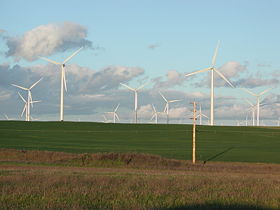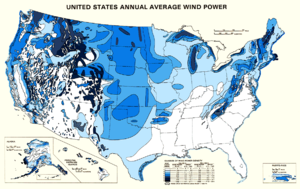Wind Powered Electricity


Using petroleum or natural gas to generate electricity when they are so critical for other uses, like powering vehicles, in regions that have lots of wind makes no environmental, economic or strategic sense. While this problem exists in every region and every country that has large "wind corridors", we focus here on an analysis of the problem in the USA.

Considerable wind speeds also occur across water bodies, in particular the North Pacific and Atlantic oceans. Since most of the world's population lives near oceans, wind farms near shorelines with strong offshore and onshore breezes could produce a significant amount of electricity (along with tide generators).
On land in the USA the major wind corridor is the Great Plains, what was once known as "The Great American Desert" in pioneer times. This primarily includes the states of North Dakota, South Dakota, Nebraska, Kansas, Oklahoma and Texas, and also extends into the states west of these up to the great mountains west, including eastern Montana, Wyoming, Colorado, and New Mexico. There are also considerable wind resources in eastern and southern Minnesota and the entire state of Iowa, diminishing south through Missouri and east through southern Wisconsin and northern Illinois, Indiana and Ohio. Parts of New York and the New England states also have considerable wind. Add to that potential the winds along coastlines and across the Great Lakes. Finally there are the higher elevations of mountains, notably the Appalachians and the mountains of the western US, including Alaska.
The Department of Energy (DOE) estimates that wind power could supply the US with 100% of its electricity, just from the Great Plains wind corridor or from offshore wind farms alone. According to the "Pickens Plan", a $10 billion wind farm with 2500 generators can supply enough energy for 1.3 million homes, and that for $1 trillion the Great Plains wind corridor could supply 20% of America's electricity. That would be about 250,000 generators to supply 130 million homes.
Electricity from wind is becoming more economical. While the construction cost for wind power is $1.5 to $2 million per megawatt (but dropping), compared $800,000 to construct a natural gas powered plant, there is no fuel cost and maintenance costs are minimal.
Connecting wind farms to the electric grid presents some problems. Wind power is intermittent - the wind doesn't always blow when electricity is needed most, and sometimes it blows when demand doesn't need it. Therefore it is not currently a reliable "base load" power source, one that runs continuously to meet a given part of a region's demand, like coal, nuclear and geothermal plants. Neither can it always be quickly ramped up and down on demand as a "peak load" source, like hydroelectric dams (and natural gas or petroleum plants) can. Since the electric grid is a transmission system without storage, "surplus" wind power has nowhere to go.
However, interconnecting enough wind farms over a broad enough area would mitigate wind power's fluctuation, because the wind will almost surely be blowing somewhere. This would make wind power a more reliable peak load source, offloading the necessity to have natural gas and petroleum plants for that purpose, and according to some studies it might even eventually become a base load power source. New forms of "grid energy storage" (e.g., charging batteries, converting it to kinetic energy in flywheels, etc.) could store surplus off-peak electricity from wind as well as other power sources.
In addition to using it as a "utility level" power source, wind power has great potential as a small-scale decentralized off-grid source. These typically don't connect to the power grid, but charge batteries. For example, small wind turbines designed for the rooftops of individual buildings are already on the market.
In places with high average wind speeds use wind power to produce electricity. In large open areas construct wind farms, and connect enough of them to the power grid to be a viable peak load - if not base load - power source, supplanting the necessity to use petroleum and natural gas plants for electricity. At individual building and facility scales, store electricity in batteries from small wind turbines.